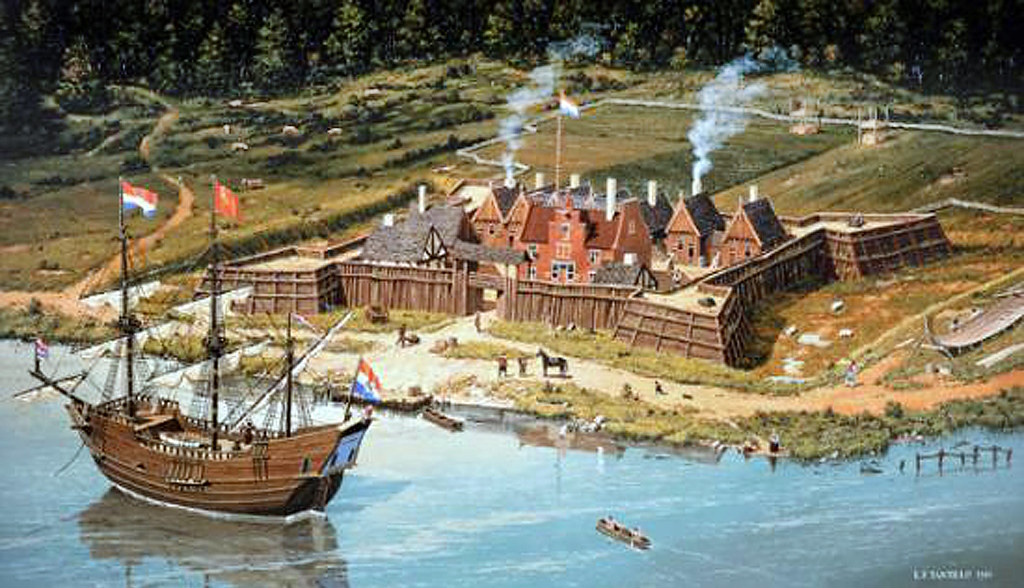Meet Lisbeth Vrooman, Speaking from 17th-Century Albany
by Ina Lee Selden
It is late August and early September of 1664 in New Amsterdam, and Lisbeth Vrooman, housewife and mother of three, is writing letters to a friend in Leiden. It is the time of the English takeover of New Netherland. She recounts her growing insecurities about the new rulers. She is gripped by fear as Native tribes fight one another very close to her home. By September her fear has turned to panic. The English have arrived in Fort Orange (Albany), and she is uncertain about the future and safety of her family. It has become difficult for her carpenter husband to find work. Thus, she has applied for a job back in the Dutch Republic. She offers condolences to Geertruij for the loss of her eldest son and one of her daughters. And she sends “four kisses” to her friend’s youngest son.
Lisbeth Vrooman’s correspondence is part of a trove of commercial and private Dutch letters discovered in England in 1980 that was seized as war booty by the English in the 17th century and held in the British National Archives in Kew, London, ever since. It takes a paleographer to decipher the handwriting. It takes a detective to parse the paragraph-long sentences and the spelling, which varies wildly depending on the region, class, and education of the writer.

To explain the context, five sea-battles were fought between the Dutch and the English in the North Sea and elsewhere in the world’s oceans during the 17th and 18th centuries. The British National Archives in Kew houses the High Court Admiralty archives. These contain papers relating to the jurisdiction of the courts, as well as ships’ books and papers, ships’ logs, and documents related to prizes. (The term prize refers to a ship or a ship’s cargo captured in naval warfare.) In 1980 a Dutch researcher stumbled upon archival material at Kew containing papers from Dutch prizes captured between 1652 and 1832. The papers consist of 1,100 boxes containing about 38,000 letters. Of these 16,000 are private letters.
Following this remarkable find, paleographers, specialists in old handwriting, have labored at Leiden University to decipher these documents in what may be a process that could be likened to the “translation” of key Dutch documents from the 17th century discovered in the New York State Library in Albany in the late 1960s. The Dutch documents include ships’ cargo records, bills of sale, and exchanges between Dutch and English officials, and they are of great interest to historians in general. But the personal letters are of compelling interest in particular to art historians, some of whom learn to read the old handwriting in a course designed by NAHC Trustee Wijnie de Groot at Columbia University, where she is Senior Lecturer in the Dutch language.
About a thousand of the letters were sent by persons in the Netherlands to New Netherland family and friends. Paleographers are in demand for this work, as the handwritten script requires special skills. In 2008, Wijnie de Groot created, with the financial support of the Dutch Language Union in The Hague, a unique four-week intensive course in the Dutch language that she teaches every summer on the Columbia campus. At her invitation, Dr. Frans Blom of the University of Amsterdam teaches paleography in one of the four weeks. “The program started with a handful of students, and just blossomed,” says Professor De Groot. “Most importantly perhaps, students develop confidence reading what was formerly daunting.”
The first students were almost exclusively historians and art historians, as they must grapple with 17th-century handwriting, such as we see in the letter of Lisbeth Vrooman, in order to access documents of importance to their work. But scholars from many other disciplines as diverse as the study of the prison life of women, climate change in the 17th century, the slave trade, native American people, the spiritual life of sailors, the Reformation, and the Counter Reformation now flock to Professor de Groot’s summer program.
One art historian, Isabella Lorez-Chavez, a graduate of the program, was recently appointed Associate Curator of European Paintings at the Fine Arts Museums of San Francisco. Ms. Lorez-Chavez says the documents give form and life to once anonymous people. “The texts, for instance, often refer to objects in the home, listing which items were in private and which in public rooms, thus providing clues to everyday life.” Such texts have helped develop her “period eye,” a way to appreciate and interpret objects and art as they might have been viewed when first created. As such the texts reveal what French historian Fernand Braudel called a people’s ingenuity, opportunism, bravery, and imagination–all qualities essential to survival anywhere, but especially in the harsh, daunting, unfamiliar world of New Netherland.
We hope you’ve enjoyed our articles and information. If you would like to contribute to help us promote and spread the history of the early New York, please click and discover more about our programs, what we offer and ways you can help.
To sponsor a post, contact us at info@newamsterdamhistorycenter.org




